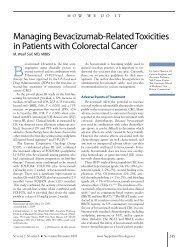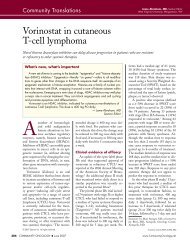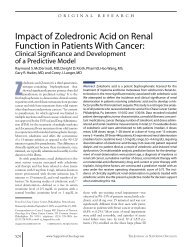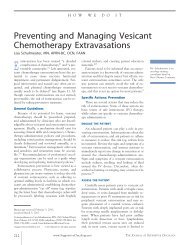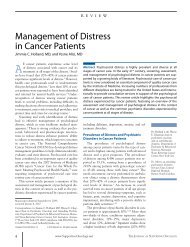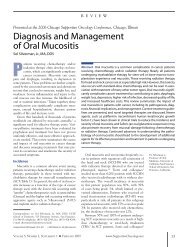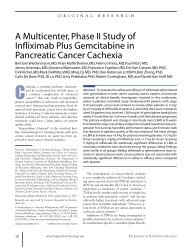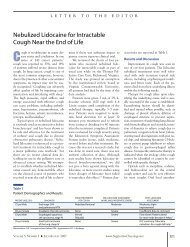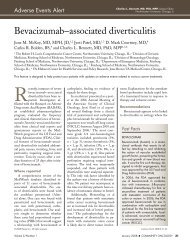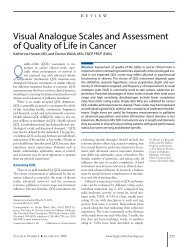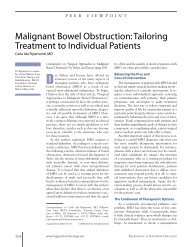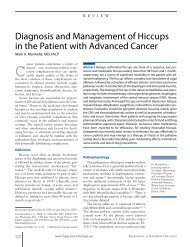Evaluating the “Good Death” Concept from Iranian Bereaved Family
Evaluating the “Good Death” Concept from Iranian Bereaved Family
Evaluating the “Good Death” Concept from Iranian Bereaved Family
You also want an ePaper? Increase the reach of your titles
YUMPU automatically turns print PDFs into web optimized ePapers that Google loves.
O R I G I N A L R E S E A R C H<br />
Symptom Experience in Patients with<br />
Gynecological Cancers: The<br />
Development of Symptom Clusters<br />
through Patient Narratives<br />
Violeta Lopez, RN, PhD, Gina Copp, RN, PhD, Lisa Brunton, RN, MSN, and<br />
Alexander Molassiotis, RN, PhD<br />
Being diagnosed with gynecological cancer<br />
is associated with high distress levels, particularly<br />
in younger patients and in advanced<br />
disease. 1 The residual effects of surgery<br />
and various treatments are known to have a<br />
profound and long-lasting impact on quality-oflife<br />
issues with significant and potentially detrimental<br />
change to women’s self-esteem, mental<br />
health, sexual functioning, and fertility. 2 Although<br />
recent medical advances have increased<br />
survival rates, few investigations have been conducted<br />
to examine <strong>the</strong> interplay of physical and<br />
psychological symptoms on this group of patients.<br />
Moreover, previous studies have focused<br />
predominantly on ga<strong>the</strong>ring quantitative data<br />
such as <strong>the</strong> frequencies and types of symptoms,<br />
with little or no information about <strong>the</strong> gynecological<br />
cancer patients’ symptom experiences. 2,3<br />
This knowledge is important to gain if we are to<br />
understand <strong>the</strong> quality-of-life and supportive<br />
care issues that affect this group of patients.<br />
Thus, our current knowledge about gynecological<br />
cancer patients’ experiences <strong>from</strong> a qualitative<br />
perspective remains limited.<br />
From <strong>the</strong> Research Centre for Nursing and Midwifery Practice,<br />
Australian National University, Medical School, Canberra,<br />
Australia; School of Health and Social Sciences,<br />
Middlesex University, London; School of Nursing, Midwifery<br />
and Social Work, University of Manchester, Manchester,<br />
United Kingdom.<br />
Manuscript submitted February 22, 2010; accepted December<br />
13, 2011.<br />
Correspondence to: Violeta Lopez, TCH, RCNMP, Building<br />
6, Level 3, East Wing, Yamba Drive, Garran, 2605, Canberra,<br />
Australian Capital Territory (ACT), Australia; telephone:<br />
�612 6244 2333; fax: �612 6244 2573; e-mail: violeta.<br />
lopez@anu.edu.au; violeta.lopez@act.gov.au<br />
J Support Oncol 2011;9:64–71 © 2011 Published by Elsevier Inc.<br />
doi:10.1016/j.suponc.2011.01.005<br />
Abstract The vast majority of <strong>the</strong> increasing cancer literature on physical<br />
and psychological symptom clusters is quantitative, attempting<br />
ei<strong>the</strong>r to model clusters through statistical techniques or to test priori<br />
clusters for <strong>the</strong>ir strength of relationship. Narrative symptom clusters<br />
can be particularly sensitive outcomes that can generate conceptually<br />
meaningful hypo<strong>the</strong>ses for symptom cluster research. We conducted a<br />
study to explore <strong>the</strong> explanation of patients about <strong>the</strong> development<br />
and coexistence of symptoms and how patients attempted to selfmanage<br />
<strong>the</strong>m. We collected 12-month qualitative longitudinal data<br />
over four assessment points consisting of 39 interview data sets <strong>from</strong> 10<br />
participants with gynecological cancer. Participants’ experiences highlighted<br />
<strong>the</strong> presence of physical and psychological symptom clusters,<br />
complicating <strong>the</strong> patients’ symptom experience that often lasted 1 year.<br />
While some complementary and self-management approaches were<br />
used to manage symptoms, few options and interventions were discussed.<br />
The cancer care team may be able to develop strategies for a<br />
more thorough patient assessment of symptoms reported as <strong>the</strong> most<br />
bo<strong>the</strong>rsome and patient-centered sensitive interventions that encompass<br />
<strong>the</strong> physiological, psychological, sociocultural, and behavioral<br />
components of <strong>the</strong> symptom experience essential for effective symptom<br />
management.<br />
The physical effects on women after being<br />
diagnosed with gynecological cancer are often<br />
attributed not only to <strong>the</strong> symptoms arising<br />
<strong>from</strong> <strong>the</strong> disease itself but, most importantly,<br />
<strong>from</strong> <strong>the</strong> side effects of treatment such as surgery,<br />
chemo<strong>the</strong>rapy, and radio<strong>the</strong>rapy. 3–5<br />
Symptoms such as fatigue, frequency of urination,<br />
bleeding, weight loss, and ascites are<br />
commonly experienced by patients, particularly<br />
those with ovarian cancers. 6 Once diagnosed,<br />
gynecological cancer patients often go<br />
on to face a prolonged course of treatments<br />
which contribute to fur<strong>the</strong>r symptoms such as<br />
chemo<strong>the</strong>rapy-induced alopecia, 7 dermatolog-<br />
64 www.SupportiveOncology.net THE JOURNAL OF SUPPORTIVE ONCOLOGY



